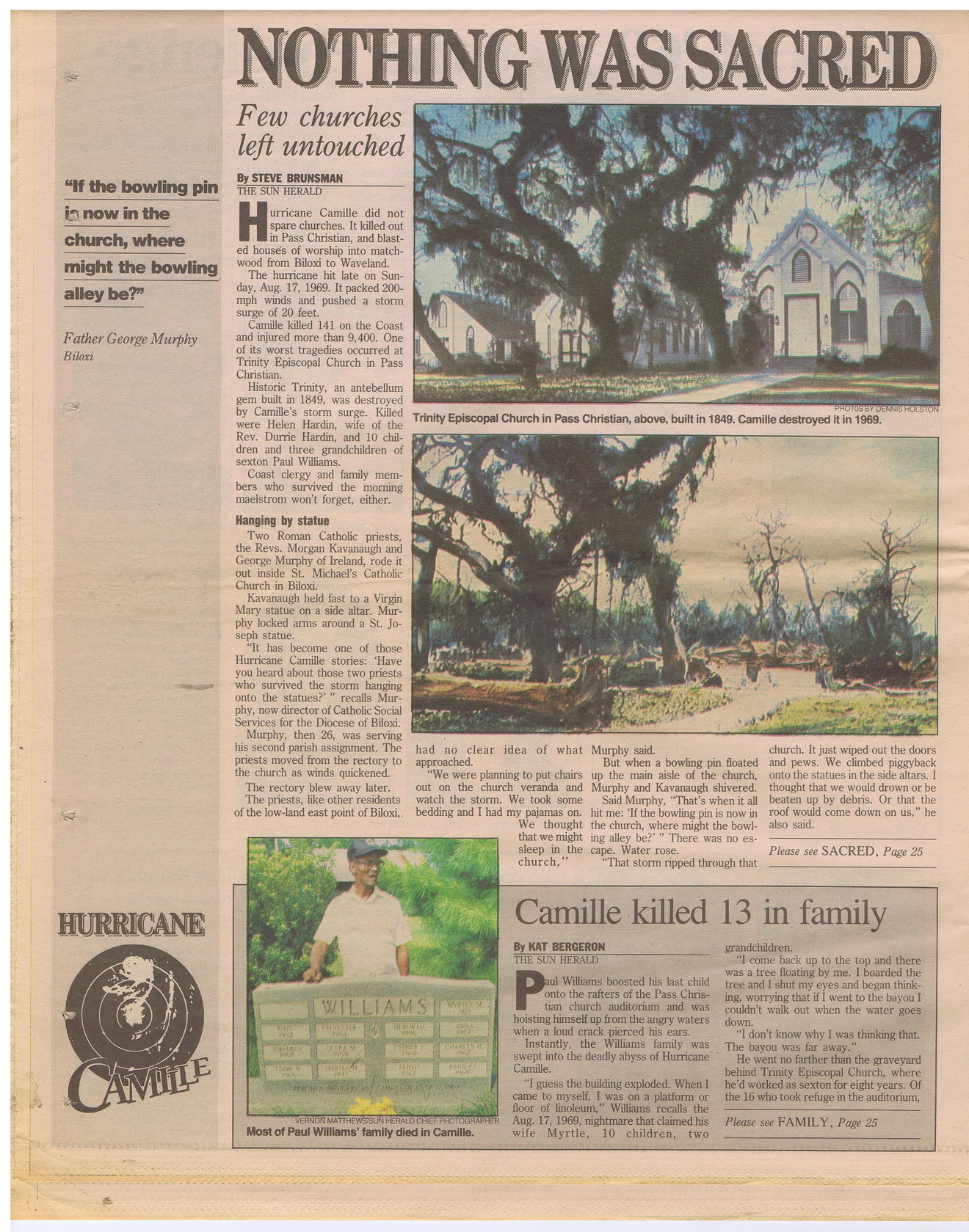This text was obtained via automated optical character recognition.
It has not been edited and may therefore contain several errors.
“If the bowling pin b now in the church, where might the bowling alley be?” Father George Murphy Biloxi Few churches left untouched By STEVE BRUNSMAN THE SUN HERALD Hurricane Camille did not spare churches. It killed out in Pass Christian, and blasted houses of worship into matchwood from Biloxi to Waveland. The hurricane hit late on Sunday, Aug. 17, 1969. It packed 200-mph winds and pushed a storm surge of 20 feet. Camille killed 141 on the Coast and injured more than 9,400. One of its worst tragedies occurred at Trinity Episcopal Church in Pass Christian. Historic Trinity, an antebellum gem built in 1849, was destroyed by Camille’s storm surge. Killed were Helen Hardin, wife of the Rev. Durrie Hardin, and 10 children and three grandchildren of sexton Paul Williams. Coast clergy and family members who survived the morning maelstrom won’t forget, either. Hanging by statue Two Roman Catholic priests, the Revs. Morgan Kavanaugh and George Murphy of Ireland, rode it out inside St. Michael’s Catholic Church in Biloxi. Kavanaugh held fast to a Virgin Mary statue on a side altar. Murphy locked arms around a St. Joseph statue. “It has become one of those Hurricane Camille stories: ‘Have you heard about those two priests who survived the storm hanging onto the statues?’ ” recalls Murphy, now director of Catholic Social Services for the Diocese of Biloxi. Murphy, then 26, was serving his second parish assignment. The priests moved from the rectory to the church as winds quickened. The rectory blew away later. The priests, like other residents of the low-land east point of Biloxi,, Trinity Episcopal Church in Pass Christian, above, built in 1849. Camille destroyed it in 1969. had no clear idea of what approached. “We were planning to put chairs out on the church veranda and watch the storm. We took some bedding and I had my pajamas on. We thought that we might sleep in the church,” Murphy said. But when a bowling pin floated up the main aisle of the church, Murphy and Kavanaugh shivered. Said Murphy, “That’s when it all hit me: ‘If the bowling pin is now in the church, where might the bowling alley be?’ ” There was no escape. Water rose. “That storm ripped through that church. It just wiped out the doors and pews. We climbed piggyback onto the statues in the side altars. I thought that we would drown or be beaten up by debris. Or that the roof would come down on us, ” he also said. Please see SACRED, Page 25 Camille killed 13 in family By KAT BERGERON *VERN'ort WATTHEW&SUN HERffiS CHIEF PHfJTOSRftPfl Most of PaulWilliams’ family died in Camille. THE SUN HERALD Paul Williams boosted his last child onto the rafters of the Pass Christian chureh auditorium and was hoisting himself up from the angry waters when a loud crack -pierced his ears. Instantly, the Williams family was swept into the deadly abyss of Hurricane Camille. “I guess the building exploded. When I came to myself, I was on a platform or floor of linoleum,” Williams recalls the Aug. 17,1969, nightmare that claimed his wife Myrtle, 10 children, two grandchildren, “I come back up to the top and there was a tree floating by me. I boarded the tree and I shut my eyes and began thinking, worrying that if I went to the bayou I couldn’t walk out when the water goes down. “I don’t know why I was thinking that. The bayou was far away.” He went no farther than the graveyard behind Trinity Episcopal Church, where he’d worked as sexton for eight years. Of the 16 who took refuge in the auditorium, Please see FAMILY, Page 25

Hurricane Camille Camille-20-Years-Later (25)